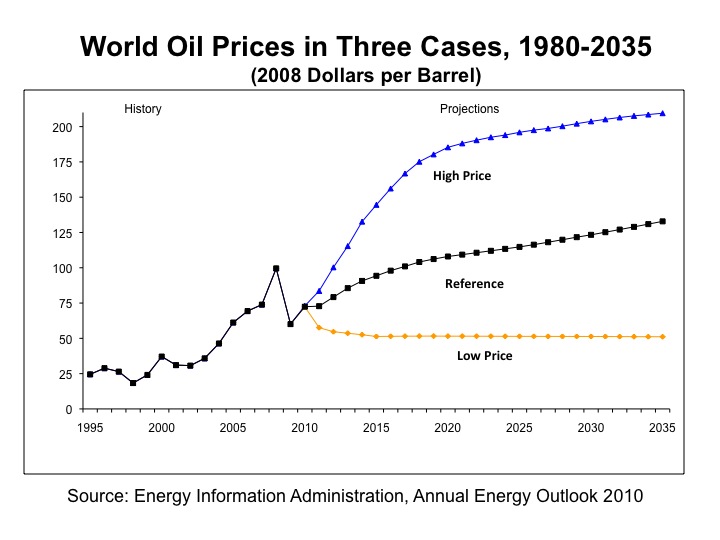Prepared by the Office of Planning, Environment and Realty @ Federal Highway Administration
www.fhwa.dot.gov/environment/climate_change/
Recent Events and Reports
FHWA‘s Climate Change Vulnerability and Risk Assessment Pilots Completed. Five areas have completed vulnerability and risk assessments of their transportation infrastructure under FHWA’s pilot program to implement a draft framework for climate change vulnerability and risk assessment. Each area took a different approach and contributed significantly to the understanding of potential climate change impacts on their transportation assets, and to the body of knowledge of the transportation community as a whole. FHWA will use the experiences of the pilots to update the draft framework. A very brief description of each pilot:
- WSDOT assessed the infrastructure it owns, including roads, rail, ferry facilities, and airports. They held workshops around the State, presenting information on climate projections and asking maintenance engineers and other employees with intimate familiarity with the assets, “What keeps you up at night?” to help identify current vulnerabilities that may be exacerbated in the future.
- A New Jersey project was led by NJTPA and was supported by an interagency partnership, including the three New Jersey MPOs, NJDOT, NJ Transit, NJ Department of Environmental Protection, and the NJ State Climatologist. The pilot closely followed the three steps of the Conceptual Risk Assessment Model in its analysis of the New Jersey Turnpike/I-95 corridor and the New Jersey Coast.
- The Oahu MPO used an interagency, multidisciplinary two-day workshop to facilitate a climate change dialog and identify five key vulnerable assets for further study. The five assets were then assessed in more detail.
- The University of Virginia developed a priority setting tool to assess how consideration of climate change and other factors may affect project prioritization in a transportation plan. They used the Hampton Roads region as a case study.
- MTC, in partnership with the San Francisco Bay Conservation and Development Commission and others, led a study of a portion of the Bay, stretching from the Oakland Bay Bridge to the San Mateo Bridge (Alameda County). This study was focused on sea level rise. The project team developed asset risk profiles for a representative list of assets within the study area, including exposure to sea level rise, sensitivity to sea level rise (based on level of use, age, seismic retrofit status, maintenance cost, and liquefaction susceptibility).
For more information see FHWA’s pilots website which includes links to the individual pilot web pages where most of the final reports are posted. Also see recordings of two webinars on the pilots to hear about the projects directly from the project leads:
- In FHWA Pilots Webinar I, Becky Lupes from FHWA gives an overview of the vulnerability and risk assessment framework, Jeff Perlman from NJTPA presents the results of the New Jersey study, and Carol Lee Roalkvam from WSDOT gives an overview of the WSDOT study.
- In FHWA Pilots Webinar II, after Becky Lupes gives a very short introduction, Brenda Dix from MTC gives an overview of the San Francisco Bay study, Jim Lambert from the University of Virginia gives an overview of the Virginia Study, and Randolph Sykes from the Oahu MPO gives an overview of the Oahu study.
FHWA Releases GHG Strategy Analysis Tool. The Energy and Emissions Reduction Policy Analysis Tool (EERPAT) was developed to assist state transportation agencies with analyzing greenhouse gas reduction scenarios and alternatives. The Tool allows agencies to quickly assess policy interactions in hundreds of scenarios. The Tool uses GreenSTEP, developed by the Oregon State DOT, as its foundation, and is expected to have regular enhancements. FHWA will be conducting pilots of the tool in early 2012. DOTs interested in participating in the pilots should contact Diane Turchetta at 202-493-0158 or diane.turchetta@dot.gov.
FHWA’s Conditions and Performance Report Includes Chapter on Climate Change Adaptation. FHWA’s bi-annual “Report to Congress” for the first time includes a chapter on climate change adaptation. The chapter includes information on projected climate change impacts to highway transportation, steps for assessing adaptation needs, discussion of adaptation options, barriers to implementation of adaptation measures, and some current adaptation activities underway by USDOT, and state and local transportation agencies.
FHWA Newsletter Highlights use of ROW for Renewable Electricity Generation. The December issue of FHWA’s Success in Stewardship Newsletter, “Utilizing the Highway Right-of-Way to Generate Renewable Energy,” highlights DOT efforts in Oregon, Ohio, Massachusetts, and North Carolina to use highway rights-of-way for solar, wind, and biofuel generation.
FAA Issues NEPA GHG Guidance. On January 12, the Federal Aviation Administration issued interim guidance on considering greenhouse gas emissions in NEPA studies. The guidance calls for including an estimate of CO2 equivalent emissions if conducting an analysis of other air emissions or if computing and reporting on fuel burn in the NEPA document.
EPA Issues Draft Guidance on Using MOVES for Estimating State and Local On-Road GHG Emissions. The draft EPA guidance, “Using MOVES for Estimating State and Local Inventories of On-Road Greenhouse Gas Emissions and Energy Consumption,” explains how to use the MOVES model to estimate greenhouse gas emissions from on road vehicles to create state or local inventories, or to estimate total energy consumption from the on-road sector. This document is posted on a new web pagethat also hosts other recent EPA publications about estimating emission reductions of both greenhouse gases and criteria pollutants from transportation efficiency strategies.
Army Corps of Engineers Issues Sea Level Rise Guidance. USACE’s “Engineering Circular 1165-2-212” provides guidance for accounting for projected future sea level rise across the project life-cycle for all Army Corps Civil Works activities. According to the Circular, local sea level rise is required to be considered in all Corps coastal activities. The circular includes some broad guidelines on how to develop and consider this information in alternatives selection for a project (pp.1-4), and also includes several appendices. One appendix is designed to help project sponsors estimate future trends in local sea level rise relevant to a specific project, while a second provides a decision-support flowchart for developing ranges of projected local sea level rise.
Report Identifies Climate Information and Assistance Needs. “Climate Adaptation & Transportation: Identifying Information and Assistance Needs” summarizes presentations and discussions from a NOAA workshop to investigate the transportation community’s needs for assistance from the climate science community, identifying the major findings and recommendations for addressing them. Workshop discussion focused on ways the climate science community can help meet transportation organizations’ needs for data, decision support tools, technical assistance, and other activities. Attendees included representatives from the transportation and climate science fields in government, academia, consulting, and the nonprofit communities. The Center for Clean Air Policy and the Environmental and Energy Study Institute led this study with funding from NOAA.
State and Local News
Florida Report Looks at Assessing Sea Level Rise on Transportation Infrastructure. A new report sponsored by the Florida Department of Transportation (FDOT), “Development of a Methodology for the Assessment of Sea Level Rise Impacts on Florida’s Transportation Modes and Infrastructure,” provides recommendations on how to assess the impacts of Sea Level Rise (SLR) on transportation infrastructure in Florida. Researchers at Florida Atlantic University (FAU) reviewed existing SLR forecasts, undertook an extensive inventory of the transportation network along the Florida coastline, and developed a methodology for identifying and assessing potentially vulnerable transportation infrastructure. The researchers applied this methodology and developed case studies for three locations in the state. The report provides recommendations to FDOT on building the impact of SLR into their planning, project development, and construction processes.
WSDOT Issues Updated Climate Change Guidance. WSDOT has issued updated guidance on considering greenhouse gas (GHG) emissions and climate change effects in project evaluations. The guidance calls for no GHG, qualitative GHG, or quantitative GHG analysis based on the class of environmental review, and provides a recommended quantitative approach for the analysis and sample language. It also addresses how climate change effects could be considered by asking project teams to ask and answer the question: “how will my project be affected by climate change?” and provides the steps and resources to do this.
Washington State Issues Framework for Addressing Climate Change Challenges. In recognition of a projected $10 billion in costs from climate change by the end of the decade, Washington State has released an “Integrated Climate Change Response Strategy” that is intended to provide a broad framework for decision-makers to use in their day-to-day work to ensure that consideration of climate change impacts is given a high priority. The strategy, “Preparing for a Changing Climate: Washington State’s Integrated Climate Response Strategy,” was completed by the Department of Ecology in collaboration with other state agencies and released April 3. It lays out a variety of threats ranging from the risks posed by a projected spike in diseases found in warmer climates such as Rocky Mountain spotted fever and tularemia to increased flooding brought on by more frequent extreme weather events.
The response plan suggests adaptive strategies such as public education to meet disease threats and floodplain restoration, with the goal of increasing water storage capacity to fend off floods. The report calls for reducing risk of damage to buildings, transportation systems, and other infrastructure by:
- Identifying vulnerable areas and taking proactive steps to reduce risks to infrastructure;
- avoiding climate risks when siting new infrastructure and planning for growth; and
- enhancing capacity to prepare for more frequent and severe flooding, rising sea levels, wildfires, and changes in energy supply and demand.
The report noted WSDOT’s recent efforts to conduct a qualitative assessment and initial screening of state-owned transportation infrastructure vulnerable to climate impacts as part of FHWA’s pilot program. The results of that assessment will be used to help prepare for future conditions and incorporate climate information into decision-making.
New York State Creates Electric Vehicle Voucher Incentive Program – The FHWA New York Division approved $10 million of Congestion Mitigation and Air Quality funds for the initial year of a statewide project entitled the “New York State Electric Vehicle Voucher Incentive Program.” This program is intended to help the private companies, public entities, and non-profit entities operating vehicles within New York State to purchase new electric-battery powered medium and heavy-duty (Class 3-8) trucks with a gross vehicle weight of 10,000 pounds or more. MPOs in all air quality nonattainment/maintenance areas of the State are being given the opportunity to endorse the statewide project on their Transportation Improvement Programs. If an MPO chooses not to endorse it, dealers in their area will not be eligible to participate. It is estimated that this incentive program will provide vouchers for at least 450 vehicles in the first year, reducing greenhouse gases by an estimated 11,700 tons and saving about 1 million gallons of diesel fuel. This project was the result of cooperative discussions between the New York Division’s Planning, Environment, and Right of Way Section, the New York State Department of Transportation, the New York State Energy Research and Development Authority, and the New York City Department of Transportation. More information is available in a press releasefrom Governor Cuomo.
New York State Releases Climate Change Adaptation Report. In an effort to provide state decision makers with information on the state’s vulnerability to climate change and to assist in the development of adaptation strategies, the New York State Energy Research and Development Authority (NYSERDA) produced “ClimAID: the Integrated Assessment for Effective Climate Change Adaptation Strategies in New York State.” The report contains a chapter on transportation infrastructure in the state, including a comprehensive description of the sector, the relevant climate hazards, and resulting vulnerabilities. The transportation chapter also outlines key adaptation strategies and important equity and environmental justice considerations.
Oregon’s TIGER III Electric Vehicle Charging Corridor Project Gets Major Boost. The Electric Vehicle Charging Corridor Connectivity Network Project in Oregon has been awarded an additional $1.34 million in TIGER III funding. The current project, originally funded with $2 million in TIGER II funding will install 22 DC fast charging stations at major destinations outside of Oregon’s metropolitan areas. The project is anticipated to begin installation in April 2012, and be completed by December 2012. The additional TIGER III funding will allow expansion of the DC fast charging stations network as envisioned in the State’s original proposal.
NJTPA Hosts International Discussion on Climate Change Adaptation. On March 28, 2012, The North Jersey Transportation Authority (NJTPA) hosted the Symposium – Adapting to Climate Change: an International Discussion. As part of a tour of US transportation agencies, researchers from the Forum of European National Highway Research Laboratories (FEHRL) met with officials from NJTPA, NJ Transit, U.S. Department of Homeland Security, Rutgers University, and others to exchange information on infrastructure resiliency and climate change adaptation activities. More information, including presentations and video recordings of the proceedings, is available on the NJTPA website.
Announcements
FHWA and AMPO Webinar on Climate Change Planning for MPOs: Effective Implementation of Traffic Operations and Management. June 26, 2012, 2:00-3:30 Eastern time. How are MPOs building on existing transportation management and operations programs to meet climate change needs? For GHG reductions? For better emergency response to extreme weather (climate) events? This webinar is free and open to all, however registration is required. This is the last in a series of six webinars on climate change sponsored by FHWA and AMPO.
Portland State University Transportation Seminar Series Explores Modeling and Climate Change – For the Spring of 2012, Portland State University’s Center for Transportation Studies Seminar Series, traditionally covering a breadth of current transportation topics, will instead focus on the single theme of transportation modeling, specifically taking a policy oriented approach and examining climate change impacts. Speakers for the series of 8 to 10 seminars will include both public and private sector transportation professionals. The series is free and open to the public. Webcasts of each seminar will be available live and archived; see www.cts.pdx.edu/seminars/ for topics and scheduling details.
If you have any suggestions for inclusion in future issues of Transportation and Climate Change News, or if someone forwarded this newsletter to you and you’d like to receive it directly in the future, please send your suggestions or request to Becky Lupes at Rebecca.Lupes@dot.gov or Heather Holsinger at Heather.Holsinger@dot.gov.















